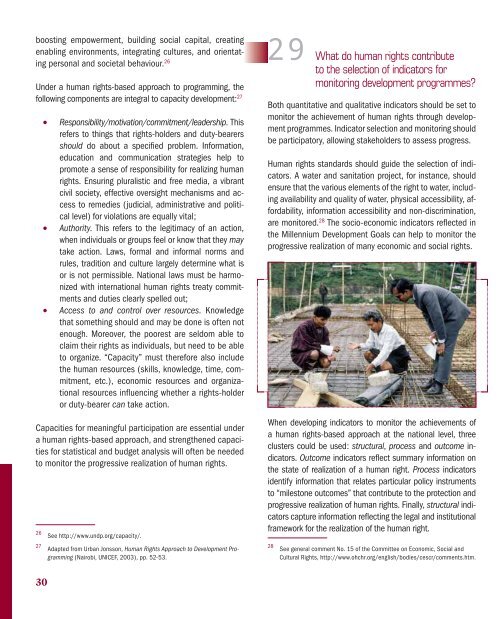Frequently Asked Questions on Human Rights-Based Approach
Frequently Asked Questions on Human Rights-Based Approach
Frequently Asked Questions on Human Rights-Based Approach
- No tags were found...
Create successful ePaper yourself
Turn your PDF publications into a flip-book with our unique Google optimized e-Paper software.
oosting empowerment, building social capital, creatingenabling envir<strong>on</strong>ments, integrating cultures, and orientatingpers<strong>on</strong>al and societal behaviour. 26Under a human rights-based approach to programming, thefollowing comp<strong>on</strong>ents are integral to capacity development: 27Resp<strong>on</strong>sibility/motivati<strong>on</strong>/commitment/leadership. Thisrefers to things that rights-holders and duty-bearersshould do about a specified problem. Informati<strong>on</strong>,educati<strong>on</strong> and communicati<strong>on</strong> strategies help topromote a sense of resp<strong>on</strong>sibility for realizing humanrights. Ensuring pluralistic and free media, a vibrantcivil society, effective oversight mechanisms and accessto remedies (judicial, administrative and politicallevel) for violati<strong>on</strong>s are equally vital;Authority. This refers to the legitimacy of an acti<strong>on</strong>,when individuals or groups feel or know that they maytake acti<strong>on</strong>. Laws, formal and informal norms andrules, traditi<strong>on</strong> and culture largely determine what isor is not permissible. Nati<strong>on</strong>al laws must be harm<strong>on</strong>izedwith internati<strong>on</strong>al human rights treaty commitmentsand duties clearly spelled out;Access to and c<strong>on</strong>trol over resources. Knowledgethat something should and may be d<strong>on</strong>e is often notenough. Moreover, the poorest are seldom able toclaim their rights as individuals, but need to be ableto organize. “Capacity” must therefore also includethe human resources (skills, knowledge, time, commitment,etc.), ec<strong>on</strong>omic resources and organizati<strong>on</strong>alresources influencing whether a rights-holderor duty-bearer can take acti<strong>on</strong>.Capacities for meaningful participati<strong>on</strong> are essential undera human rights-based approach, and strengthened capacitiesfor statistical and budget analysis will often be neededto m<strong>on</strong>itor the progressive realizati<strong>on</strong> of human rights.2627See http://www.undp.org/capacity/.Adapted from Urban J<strong>on</strong>ss<strong>on</strong>, <strong>Human</strong> <strong>Rights</strong> <strong>Approach</strong> to Development Programming(Nairobi, UNICEF, 2003), pp. 52-53.29 What do human rights c<strong>on</strong>tributeto the selecti<strong>on</strong> of indicators form<strong>on</strong>itoring development programmes?Both quantitative and qualitative indicators should be set tom<strong>on</strong>itor the achievement of human rights through developmentprogrammes. Indicator selecti<strong>on</strong> and m<strong>on</strong>itoring shouldbe participatory, allowing stakeholders to assess progress.<strong>Human</strong> rights standards should guide the selecti<strong>on</strong> of indicators.A water and sanitati<strong>on</strong> project, for instance, shouldensure that the various elements of the right to water, includingavailability and quality of water, physical accessibility, affordability,informati<strong>on</strong> accessibility and n<strong>on</strong>-discriminati<strong>on</strong>,are m<strong>on</strong>itored. 28 The socio-ec<strong>on</strong>omic indicators reflected inthe Millennium Development Goals can help to m<strong>on</strong>itor theprogressive realizati<strong>on</strong> of many ec<strong>on</strong>omic and social rights.When developing indicators to m<strong>on</strong>itor the achievements ofa human rights-based approach at the nati<strong>on</strong>al level, threeclusters could be used: structural, process and outcome indicators.Outcome indicators reflect summary informati<strong>on</strong> <strong>on</strong>the state of realizati<strong>on</strong> of a human right. Process indicatorsidentify informati<strong>on</strong> that relates particular policy instrumentsto “milest<strong>on</strong>e outcomes” that c<strong>on</strong>tribute to the protecti<strong>on</strong> andprogressive realizati<strong>on</strong> of human rights. Finally, structural indicatorscapture informati<strong>on</strong> reflecting the legal and instituti<strong>on</strong>alframework for the realizati<strong>on</strong> of the human right.28See general comment No. 15 of the Committee <strong>on</strong> Ec<strong>on</strong>omic, Social andCultural <strong>Rights</strong>, http://www.ohchr.org/english/bodies/cescr/comments.htm.30
















